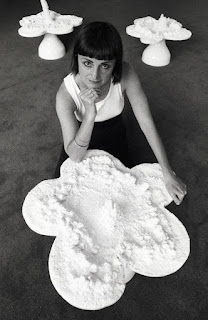Photo by Kippa Matthews (1992)
I.
For most British people, a piss artist is one who likes to get drunk, act the fool, produce shoddy work and generally waste time. In other words, one who gets pissed a little too often; pisses around a little too much; and pisses people off more than is deemed acceptable.
However, for some of us, the term also triggers thoughts of Warhol, Chadwick and Serrano and here I would like to discuss a famous work by the second of these three piss artists, Helen Chadwick ...
II.
The British artist Helen Chadwick died (relatively) young - she was only 42 - but not before she completed the work by which I, like many of her admirers, best remember her - Piss Flowers (1991-1992).
Piss Flowers is a work composed of twelve sculptures made by quite literally pissing in the Canadian snow and then pouring plaster into the (pre-cut) flower-shaped cavities left by the warm streams of urine.
These casts were then attached to stem-like pedestals based on the fat-bodied shape of a hyacinth bulb, before being cast in bronze and enamelled white.
If it sounds like all good clean fun (whatever that means), Chadwick insisted that, actually, it was hard work producing the dozen finished pieces and they also cost her £12,000, which might sound like a small or large sum of money, depending on one's circumstances [1].
The Piss Flowers were displayed (on artificial grass) as part of Chadwick's solo exhibition - amusingly entitled Effluvia - at the Serpentine Gallery, in the summer of 1994 [2]. Happy days ...
III.
Enchanted by the fact that the majority of flowering plants possess both male and female sexual organs and have found a way to incorporate sexual difference into their singular being, Chadwick wanted to produce a work which celebrated this via a form of erotic play, or what she describes in a poem written at the same time as "Gender-bending water sport" [3].
Thus, it was important that she and her male partner, David Notarius, both pissed into the snow; she using her liquid waste to create the central phallic-shaped pistil and he directing his urine to produce the delicate, labial-looking circumference. In the same poem referred to above, Chadwick writes of "Vaginal towers with male skirt" [4].
Later, she would describe Piss Flowers as a metaphysical conceit - and a deeply romantic work in which two people are united as one via bodily expression. It might also be seen, as one commentator rightly points out, as an example of indexical art - i.e., art that doesn't appear to be authored but directly preserving an imprint of reality (an idea that had long fascinated Chadwick).
Whether one finds the flowers beautiful or repulsive (or both) is, of course, a matter of individual judgement; one local councillor up in the East Midlands was quoted by the Nottingham Evening Post
as saying: "I doubt the minds of the people who can create things like
this." [5]
Whilst personally I wouldn't want a fleur de pisse planted in my back garden, I do admire Chadwick's attempts to create things of beauty out of unconventional materials, such as bodily fluids and base matter.
And her attempt to effect a becoming-plant by entering into an unnatural alliance with the snow in such a manner that queer forms blossom from molecular forces is not only artistically daring but - from a Deleuzean perspective - philosophically interesting.
One can't help wondering what would Linnaeus say ...?
Notes
[1] £12,000 in 1992 was the equivalent to around £31,000 today.
[2] Effluvia received widespread critical attention and national press coverage. It was seen by over 54,000 visitors - a record number for the gallery at that time.
[3] Helen Chadwick, 'Piss Posy' (1992).
Unfortunately, I cannot locate this poem online and do not know if it was ever published. However, I did come across (what I think is termed) an ekphrastic poem written by Jo Shapcott, entitled 'Piss Flower' (2018), which can be read online (thanks to The Poetry Archive) by clicking here. It is clearly inspired by Chadwick's work.
[4] Helen Chadwick, 'Piss Posy' (1992).
[5] The fact that this censor-moron was a councillor up in D. H. Lawrence country only goes to show how little things have changed; 60-odd years earlier, Lawrence's art was attacked as the work of a depraved sex maniac - including his watercolour Dandelions (1928), which famously depicts a man pissing on some flowers: click here.
To read the first post in this series - on Andy Warhol's Piss and Oxidation Paintings (1977-1978) - please click here.
To read the third post in this series - on Andres Serrano's Piss Christ (1987) - please click here.

.jpg)